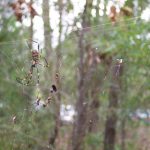Socially-induced developmental plasticity
For years we’ve known that the environment can moderate individual development; tadpoles respond to a drying pond by maturing faster, Daphnia grow spiny heads and tails to defend against predators when they are present. There are numerous examples of how the environment, and thus natural selection, affects how individuals develop in an adaptive way.
Despite this understanding, studies largely ignored whether the social environment, the density and quality of surrounding mates and rivals, could affect individuals in a similar way.
We have been instrumental in demonstrating that individuals moderate not only life-history and morphological traits, but also physiological and behavioural traits in response to the conspecific social environment. Individuals are thus actively responding to cues of competition and mate availability and altering their development in adaptive ways. Our research demonstrates how developmental plasticity is also under sexual selection, rather than just natural selection.
Representative papers:
1. Kasumovic, M. M., and M. C. B. Andrade. 2006. Male development tracks rapidly shifting sexual versus natural selection pressures. Current Biology 16:R242-R243. (pdf)
2. Kasumovic, M. M., M. D. Hall, H. Try, and R. Brooks. 2011. The importance of listening: Developmental shifts in response to juvenile acoustic environment. Journal of Evolutionary Biology 24:1325-1334. (pdf)
3. Stoltz, J. A., M. C. B. Andrade, and M. M. Kasumovic. 2012. Plasticity in metabolic rates reinforces morphological plasticity in response to social cues of sexual selection. Journal of Insect Physiology. 58: 985-990. (pdf)
4. Kasumovic, M. M., and R. Brooks. 2011. It’s all who you know: The evolution of socially-cued anticipatory plasticity as a mating strategy. Quarterly Reviews in Biology. 84:181-197. (pdf)
Understanding gender differences in video game preference and play
Video games are now the most popular medium of our generation. They are in almost every home in the developed country, and mobile phones make it possible for everyone to carry them around in their pockets. Despite the popularity of video games, apart from arguements about ehether video games cause aggression and violence, we still know very little about what video games do to us. More importantly, we have a poor understanding of what drives so many people to play video games, and why differences in video games preferences exist.
We take an evolutionary approach to understanding the popularity of video games by focusing on how our evolved bodies and brains respond to different competitive games. As winning and losing in video games trigger very similar pathways to winning and losing in other competitions, we can make predictions about when, why and who should respond to stimuli, helping us understand behaviours such as aggression, addiction, and other prolem behaviours. We are only beginning to explore the crossroads of video games and evolution, but it will be a lot of fun!
Representative papers:
1. Kasumovic, M.M. and Kuznekoff, J.H. 2015. Player performance in a first person shooter video game moderates positive and negative statements toward female players. PLoS ONE: In review.
2. Kasumovic, M.M, Blake, K., Dixson, B., and Denson, T. F, 2015. Socio-sexual inventory and self-perceived mate value are associated with playing violent video games in men and women. Personality and Individual Differences: In review.
For now check out The Conversation articles we’ve written here.
What is quality and how does it relate to a phenotype?
What makes some individuals succeed where others failed? In evolutionary biology, researchers love equating whatever traits led to success with quality. Very quickly, quality became synonymous with whatever is good in an individual.
A recent realization is that the same traits don’t confer success in all environments. More importantly, environemnts vary, and quite rapidly! As a result, there is no universal definition of quality as was previously envisioned.
Our research and reviews highlight that quality is context specific, and without understanding all the different competitive contexts, there’s no real understanding of quality. We show that it is important to understand relationships between traits in different phenotypic dimensions (e.g., physiology, morphology, life-history, behaviour). Only when exploring all the different dimensions will we truly understand what a phenotype is.
Representative papers:
1. Kasumovic, M. M., M. J. Bruce, M. C. B. Andrade, and M. E. Herberstein. 2008. Spatial and temporal demographic variation drives within-season fluctuations in sexual selection. Evolution 62:2316-2325. (pdf)
2. Jordan, L.A., Kokko, H. and Kasumovic, M.M. 2014. Spider males choose mates by selecting among competitive environments. American Naturalist. (pdf)
3. Lailvaux, S. P., and Kasumovic, M. M. 2011. Defining individual quality over lifetimes and selective contexts. Proceedings of the Royal Society B: Biological Sciences 278:321-328. (pdf)
4. Kasumovic, M.M. 2013. The multi-dimensional consequences of the juvenile social environment: towards an integrative view of the adult phenotype. Animal Behaviour. 85:1049-1059 (pdf)
Competition is much more…competitive than we thought.
In a fight, big guys win and little guys lose, right? It turns out it’s not always the case as the literature is filled with studies that demonstrate a bigger males losing (though this stuff is kept on the down-low).
How do males decide a winner, and if it’s not size, what is it? And what about females, surely they defend resources too?
Our studies examining male assessment strategies, the internal and external factors determining competitive outcomes have shaped theories about contest escalation. We also show that previous experience affects future performance and highlight the importance of time in competitive interactions. We also demonstrate the importance of physiology in competitive outcomes, a factor not well explored in the literature.
Representative papers:
1. Elias, D. O., M. M. Kasumovic, D. Punzalan, M. C. B. Andrade, and A. C. Mason. 2008. Assessment during aggressive contests between male jumping spiders. Animal Behaviour 76:901-910. (pdf)
2. Kasumovic, M. M., D. O. Elias, D. Punzalan, A. C. Mason, and M. C. B. Andrade. 2009. Experience affects the outcome of agonistic contests without affecting the selective advantage of size. Animal Behaviour 77:1533-1538. (pdf)
3. Kasumovic, M. M., A. C. Mason, M. C. B. Andrade, and D. O. Elias. 2011. The relative importance of RHP and resource quality in contests with ownership asymmetries. Behavioral Ecology 22:39-45. (pdf)
4. Kasumovic, M.M. and Seebacher, F. 2013. The active metabolic rate predicts a male spider’s proximity to females and expected fitness. Biology Letters 9:dx.doi.org/10.1098/rsbl.2012.1164 (pdf)




